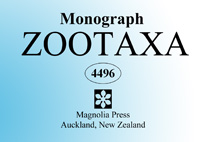Abstract
Three new species of the genus Amynthas are described from Guangxi Province, China. They are named A. dissimilis sp. nov., A. anteporus sp. nov. and A. marsupiformis sp. nov. All of them have two pairs of spermathecal pores in 6/7–7/8, and belong to the tokioensis-group. Their morphological characteristics are compared to similar species in tokioensis-group from China and other Asian countries. In addition, the mitochondrial COI and 12S-tRNA-Val-16S sequence of three new species were determined, then pairwise distances between species were calculated. Both morphological and molecular evidences could easily distinguish the new species from earthworms previously reported in the tokioensis-group.
References
Bely, A.E. & Wray, G.A. (2004) Molecular phylogeny of naidid worms (Annelida: Clitellata) based on cytochrome oxidase I. Molecular Phylogenetics and Evolution, 30 (1), 50–63.
https://doi.org/10.1016/S1055-7903(03)00180-5Chen, Y. (1946) On the terrestrial Oligochaeta from Szechuan Ⅲ. Journal of the West China Border Research Society, 16, 83–141.
Domínguez, J., Aira, M., Breinholt, J.W., Stojanovic, M., James, S.W. & Pérez-Losada, M. (2015) Underground evolution: New roots for the old tree of lumbricid earthworms. Molecular Phylogenetics and Evolution, 83, 7–19.
https://doi.org/10.1016/j.ympev.2014.10.024Fang, P.W. (1929) Notes on a new species of Pheretima from Kwangsi, China. China Sinensis, 1 (2), 15–24.
Folmer, R.H.A, Nilges, M., Folkers, P.J.M., Konings, R.N.H. & Hilbers, C.W. (1994). A model of the complex between single-stranded DNA and the single-stranded DNA binding protein encoded by gene V of filamentous bacteriophage M13. Journal of Molecular Biology, 240, 341–357.
https://doi.org/10.1006/jmbi.1994.1449Gates, G.E. (1972) Burmese earthworms: an tntroduction to the systematics and biology of Megadrile Oligochaetes with special reference to Southeast Asia. Transactions of the American Philosophical Society, 62, 1–326.
https://doi.org/10.2307/1006214Hong, Y. & James, S.W. (2001) New species of Korean Amynthas Kinberg, 1867 (Oligochaeta, Megascolecidae) with two pairs of spermathecae. Revue Suisse De Zoologie, 108 (1), 65–93.
https://doi.org/10.5962/bhl.part.79621Hong, Y. & Lee, W.K. (2001) Description of three new Korean earthworms of the genus Amynthas Kinberg, 1867 (Oligochaeta, Megascolecidae) with multiple genital markings. Revue Suisse De Zoologie, 108 (2), 283–290.
https://doi.org/10.5962/bhl.part.79630Hong, Y., Lee, W.K. & Kim, T.H. (2001) Four new species of the genus Amynthas Kinberg (Oligochaeta: Megascolecidae) from Korea. Zoological Studies, 40 (4), 263–268.
Huang, J., Xu, Q., Sun, Z.J., Tang, G.L. & Su, Z.Y. (2007) Identifying earthworms through DNA barcodes. Pedobiologia, 51 (4), 301–309.
https://doi.org/10.1016/j.pedobi.2007.05.003Larkin, M.A., Blackshields, G., Brown, N.P., Chenna, R., McGettigan, P.A., McWilliam, H., Valentin, F., Wallace, I.M., Wilm, A., Lopez, R., Thompson, J.D., Gibson, T.J. & Higgins, D.G. (2007) Clustal W and Clustal X version 2.0. Bioinformatics, 23, 2947–2948.
https://doi.org/10.1093/bioinformatics/btm404Novo, M., Almodóvar, A., Fernández, R., Trigo, D. & Díaz Cosín, D.J. (2010) Cryptic speciation of hormogastrid earthworms revealed by mitochondrial and nuclear data. Molecular Phylogenetics and Evolution, 56, 507–512.
https://doi.org/10.1016/j.ympev.2010.04.010Pérez-Losada, M., Ricoy, M., Marshall, J.C. & Domínguez, J. (2009) Phylogenetic assessment of the earthworm Aporrectodea caliginosa species complex (Oligochaeta: Lumbricidae) based on mitochondrial and nuclear DNA sequences. Molecular Phylogenetics and Evolution, 52, 293–302.
https://doi.org/10.1016/j.ympev.2009.04.003Perrier, E. (1872) Recherche pour servir à l’histoire des lombriciens terrestres. Nouvelles Archives du Museum d’HistoireNaturelle de Paris, 8, 7–198.
Pop, A.A., Wink, M. & Pop, V.V. (2003) Use of 18s, 16s rDNA and cytochrome c oxidase sequences in earthworm taxonomy (Oligochaeta, Lumbricidae). Pedobiologia, 47 (5), 428–433.
https://doi.org/10.1078/0031-4056-00208Qiu, J.P., Wang, W. & Wang, H. (1991) Notes on a new species of genus Amynthas from Guizhou Province, China. Guizhou Science, 4, 301–304.
Sims, R.W. & Easton, E.G. (1972) A numerical revision of the earthworm genus Pheretima auct. (Megascolecidae: Oligochaeta) with the recognition of new genera and an appendix on the earthworms collected by the Royal Society North Borneo Expedition. Biological Journal of the Linnean Society, 4, 169–268.
https://doi.org/10.1111/j.1095-8312.1972.tb00694.xSun, J., Zhao, Q. & Qiu, J.P. (2010) Three new species of earthworms belonging to the genus Amynthas (Oligochaeta: Megascolecidae) from Hainan Island, China. Zootaxa, 2680, 26–32.
Sun, J., Zhao, Q., Jiang, J.B. & Qiu, J.P. (2013) New Amynthas species (Oligochaeta: Megascolecidae) from south and central Hainan Island, China and estimates of evolutionary divergence among some corticis-group species. Journal of Natural History, 47 (17–18), 1143–1160.
https://doi.org/10.1080/00222933.2012.743613Tamura, K., Peterson, D., Peterson, N., Stecher, G., Nei, M. & Kumar, S. (2011) MEGA5: molecular evolutionary genetics analysis using maximum likelihood, evolutionary distance, and maximum parsimony methods. Molecular Biology and Evolution, 28, 2731–2739.
https://doi.org/10.1093/molbev/msr121Wu, J.H. & Sun, X.L. (1997) On one new species of Amynthas (Oligochaeta: Megascolecidae) from China. Sichuan Journal of Zoology, 1, 3–5.
Zhang, W.X., Li, J.X. & Qiu, J.P. (2006) New earthworms belonging to the genus of Amynthas Kinberg (Megascolecidae: Oligochaeta) and Drawida Michaelsen (Moniligastridae: Oligochaeta) from Guangdong, China. Journal of Natural History, 40 (7–8), 395–401.
https://doi.org/10.1080/00222930600661987

